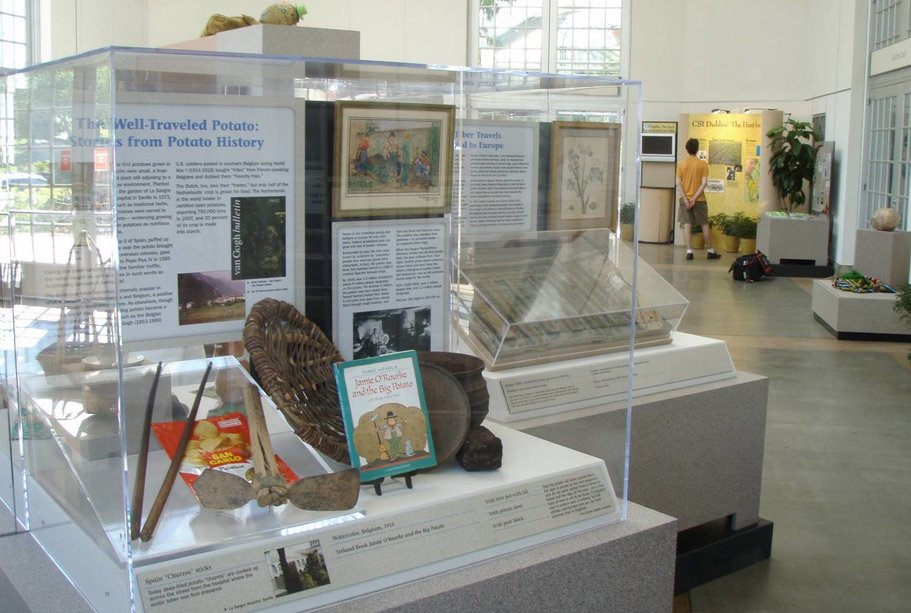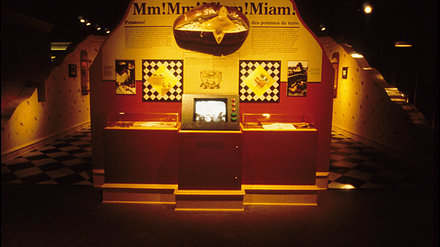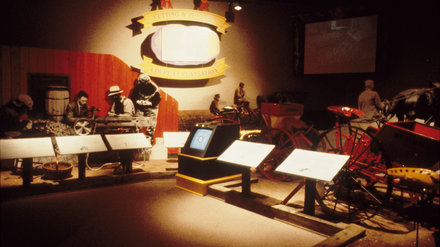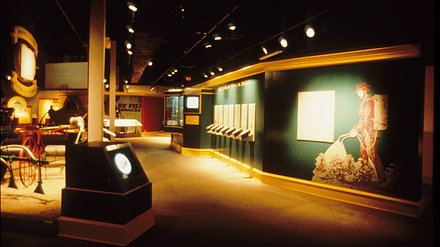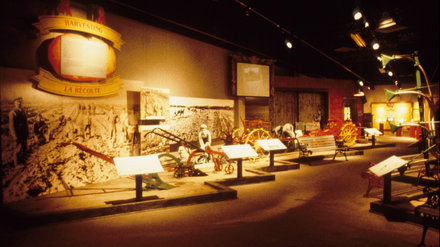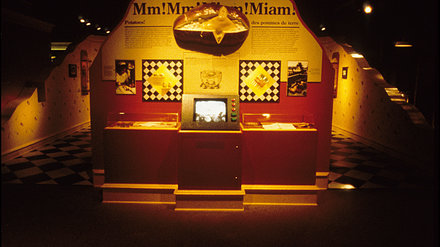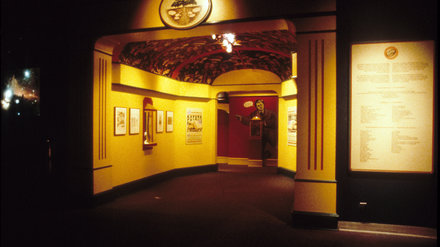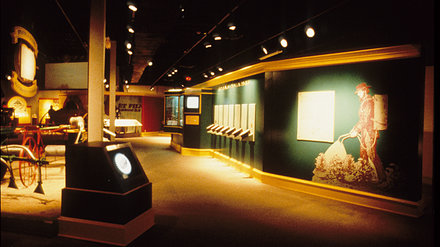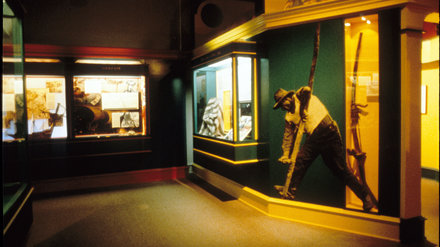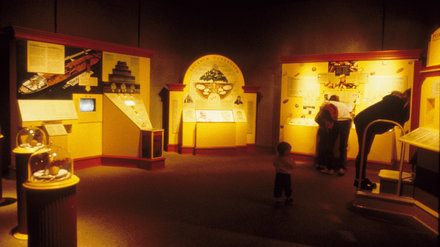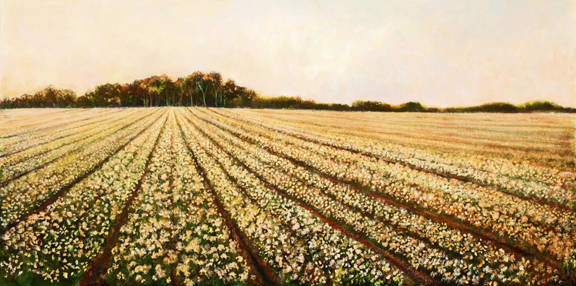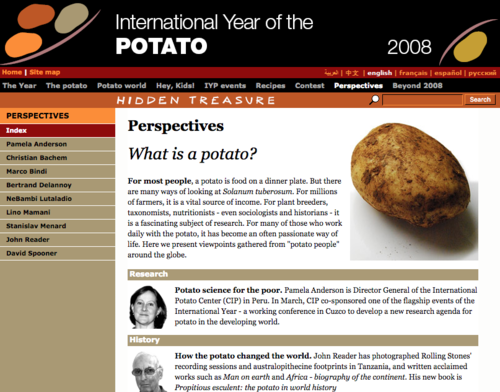- Home
- About
- Exhibits
- The Well-Traveled Potato
- Delicious
- Potatoes 101 and Fun Science and Art Projects for All Ages
- Potato Fun: Heads, Puns and Guns
- Cinematic and Musical Potatoes
- Surprising
- Praiseworthy
- Potato People
- Potato Places
- Book Shop
- Wide World of Potatoes: Links
- Contact Us
- Buy The Collection? Set Up TPM in Your Country/Community?
Welcome to The Potato Museum
Here is the latest edition of The Potato Museum, online since the early 90s, with features, exhibits from our collections as well as interactive modules, teacher and student resources, our Facebook page and shop. The Potato Museum, started in 1975 in Brussels, Belgium, is the world's first museum about the potato and features the planet's largest collection about this valuable vegetable. It also may well be the first museum to be online, especially one about food.
Not a product of the potato industry, The Potato Museum is an educational organization dedicated to exploring the potato's fascinating past, controversial present and promising future. The collection has been featured in major exhibitions at the Smithsonian's Museum of Natural History ("Seeds of Change" 1991-2), Canada's National Museum of Science and Industry ("The Amazing Potato" 1992-93) and the U.S. Botanic Garden ("Spuds Unearthed" 2010.)
If You Should Want to Own the World’s Largest Collection on the History and Social Influence of the Potato, Now is the Time
We’re looking for a buyer for the collection, which comprises well over 2000 items, in addition to a potato book library. The objects range from agricultural and kitchen tools to spud-themed movie clips; the collection includes toys and games, lithographs, musical instruments, South American hand tools and clay images, botanicals, old photos, postcards and stamps, potato chip, mashies, and fries items galore, dolls and jewelry, menus, currency, paintings and prints, sports memorabilia, posters and potato sacks. And more.
Or contact us with your ideas for a permanent home for The Potato Museum.
We welcome your inquiries. Email us via thepotatomuseum@gmail.com
Enjoy a quick walkabout of Spuds Unearthed!, an exhibition at the US Botanic Garden, in Washington, DC that ran from May-October 2010. The Potato Museum collaborated with USBG on the project.
Spuds Unearthed! at the US Botanic Garden, Washington, DC
"Spuds Unearthed!" U.S. Botanic Garden, Washington, DC Summer and Fall 2010
A comprehensive exhibition on the history, social influence and science of the potato, created from the Potato Museum collection filled the entire east wing of the Botanic Garden’s Conservancy. In addition, scientists at Michigan State created an indoor growing chamber in which visitors could see the above ground leafy green potato plant and then, by lifting a flexible panel, observe the below ground scene of root networks and swelling tubers. Besides curating the exhibit, we developed hands-on activity carts and scripts for the docents we trained to use with visitors. We also gave gallery talks and workshops for educators. We organized an entire weekend public workshop on the “science of the potato” with hands-on activities at ten different stations.
The Potato Museum's "Amazing Potato" Exhibition at Canada's Museum of Science and Technology
Canada’s National Museum of Science and Technology's 6,000 square foot exhibition, "The Amazing Potato," was the first show celebrating the museum’s grand reopening after being closed for renovations. The directors had conducted a national survey to discover what Canadians wanted to see exhibited and the potato topped the list. Prior to all that The Potato Museum's co-founder, Tom Hughes, had been interviewed on the popular cross-Canada radio program, "As It Happens," talking about the mighty potato, which may have influenced the survey. The exhibition, drawn heavily on the Hughes' potato collection and research proved so popular it was extended for a second year. It remains the standard for how the potato’s story should be told.
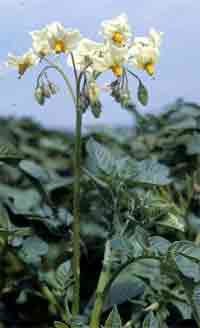
Why The Potato?
In his 1998 book, Man on Earth, author John Reader said it well:
Seeing the beauty of a potato field in bloom for the first time surprises many people. Its flowers--clean white, blush pink, soft violet, even a deep blue. And its simple parallel lines, green alternating with color. Agricultural landscapes hold their own with any other.
The potato itself is unique among plants for its quiet influence on the world's history and culture. From its origins in the Andes mountains, the potato has traveled farther than any vegetable, around the globe and to the outskirts of the Moon. It has inserted deep roots in places where people think it has always been. That's why many call it the "Irish potato," or the Idaho spud.
In the space of just 400 years, the potato has become a staple crop of many people around the world whose antecedents had subsisted perfectly well upon grain crops for anything up to 4000 years. The reason for this somewhat surprising development is that the potato is the best all-around bundle of nutrition known to mankind.
Its ration of carbohydrate to protein is such that anyone eating enough potatoes to satisfy their energy requirements will automatically obtain most of the protein they require. Furthermore, the "biological value" of potato protein (an index of the nitrogen absorbed from a food and retained by the body for growth and maintenance) is 73, second only to eggs at 96; just ahead of soybeans at 72, but far superior to corn (maize) at 54 and wheat at 53.
Potatoes also contain significant amounts of essential vitamins (the British, in fact, used to derive 30% of their vitamin C intake from potatoes.) Exceptional productivity is another virtue of the potato. A field of potatoes produces more energy per hectare per day than a field of any other crop. Potatoes grow well from sea level to 14,000 feet on a wider variety of soils, under a wider range of climatic conditions, than any other staple food. The potato matures faster in 90 to 120 days, and will provide small but edible tubers in just 60 days.
All in all, the potato is about the world's most efficient means of converting plant, land, water and labour into a palatable and nutritious food.
Reader's book Potato, A History of the Propitious Esculent, was published in 2009.
Listen to Meredith and Tom Hughes Discuss the Potato, Their Museum and The International Year of the Potato with Melissa Block of NPR's "All Things Considered."
On New Year's Eve we donned our potato skins and did an interview with Melissa Block for All Things Considered on National Public Radio. Her producer called us in line with the United Nations' dubbing of 2008 as the International Year of the Potato.
While you listen (laptop only) view exhibits on our former and still relevant blog "PotatoheadsTalking."
http://foodmuseum.typepad.com/potato_museum_blog/2008/01/spuds-on-npr.html
Follow us on Facebook
Enter your custom Javascript or HTML content here

